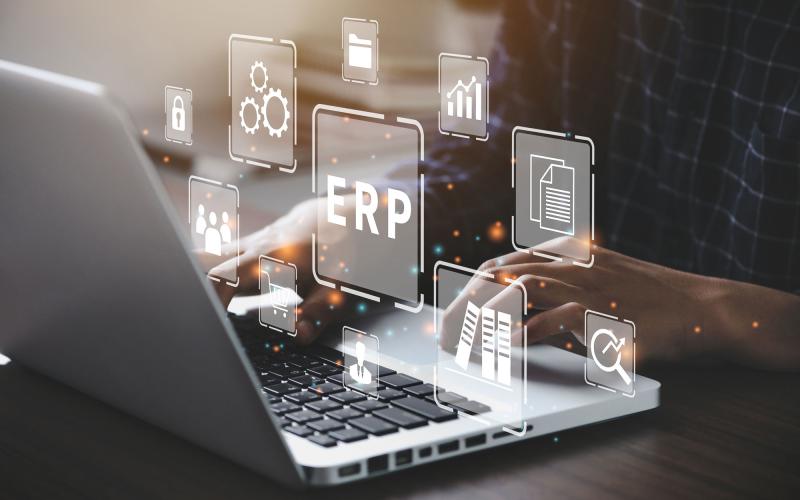5 Signs Your ERP System is Holding You Back

1. Relying on other technology to fill the gaps
A clear sign that your ERP system is falling short is when employees are regularly turning to spreadsheets or other business applications for core activities, such as managing data, tracking workflows or building reports. This over reliance on manual processes leaves your business more open to human errors, with version control issues and fragmented views of your business operations, plus a lack of centralised control.
These workarounds also reflect a deeper issue: your ERP isn’t aligned to how your business really operates. Rather than adapting to new processes or requirements, it forces your teams to find alternative approaches, decreasing both efficiency and data integrity. Completing a full audit of where and how teams are using other IT tools can help uncover these pressure points. These gaps represent critical areas where your ERP system needs to, at minimum, evolve or, ideally, be replaced.
2. Reporting takes too long — and you don’t fully trust the numbers
If generating reports is slow, difficult or dependent on IT support, your ERP system may be limiting your organisation’s ability to make informed decisions. When data is siloed across departments or systems, compiling it into a single report becomes a time-consuming exercise, and one that often results in outdated or incomplete insights. Worse still, leadership doesn’t fully trust the accuracy of the numbers and it undermines confidence in the entire decision-making process.
In today’s fast-moving environment, real-time access to reliable data isn’t a luxury – it’s a necessity. You need to be able to track Key Performance Indicators (KPIs), identify trends, and respond to change in the moment, not days or weeks later. If your current ERP system can’t provide that visibility, it’s time to re-evaluate your approach. Start by identifying which metrics take the longest to report and why. A modern ERP should offer integrated analytics, customisable dashboards, and self-service reporting — no workarounds or IT tickets required.
3. You’re paying more to maintain than to improve your ERP software
Legacy ERP systems often come with a high cost of ownership that isn’t always obvious at first glance. Between annual maintenance fees, license renewals, customisations, third-party consultants, and infrastructure costs, your organisation may be spending a disproportionate amount of its budget just to keep the system running, and with little room left for innovation. If you find that more of your ERP investment goes toward maintenance than meaningful improvement, you’re essentially paying to stay in place.
And, let’s be honest, that’s a red flag! In a competitive business landscape, your ERP budget should be enabling growth, not draining resources. Conducting a full analysis of your system’s total cost of ownership, factoring in both direct and indirect costs, can be eye-opening. When compared to modern cloud-based ERP platforms, which offer lower overhead and continuous updates, many organisations discover they can reduce costs and gain more flexibility by simply making a change.
4. Integrations are clunky — or non-existent
In a connected digital ecosystem, your ERP system needs to integrate seamlessly with others, whether it’s your CRM, HR software, e-commerce platform, or other critical applications. If your current system lacks built-in integrations or requires costly, time-consuming workarounds to connect data across platforms, you’re likely wasting time and creating unnecessary complexity. Manual data entry, duplicate records, and constant reconciliation are all signs that your tech stack is not working as one.
This lack of integration doesn’t just create inefficiencies; it creates risk. Disconnected systems lead to inconsistent data, slower processes, and poor visibility across departments. To identify where integration gaps are hurting you most, look for areas where teams frequently copy and paste between systems or rely on spreadsheets to transfer data. These are pain points a modern ERP system, with open APIs and native integrations, can help eliminate, restoring productivity and data integrity.
5. Security and compliance risks Are rising
Security and compliance are non-negotiable — especially for organisations operating in regulated industries. Yet, many older ERP systems were not built to handle today’s evolving cybersecurity threats or regulatory demands. If you’re constantly patching vulnerabilities, layering on third-party tools, or scrambling to meet compliance updates, your ERP software may be putting your organisation at risk.
The consequences of a breach or failed audit are steep, hefty fines up to much as 10% of global turnover, legal exposure, and lost customer trust. Modern ERP systems are designed with these realities in mind. They offer built-in tools for data encryption, audit trails, role-based access, and automated compliance updates. If your current ERP can’t support these capabilities out of the box, it may be time to consider a system that can.
Next step: Don’t just replace – upgrade smarter
Recognising the signs that your ERP system is holding you back is the first step. But moving forward requires more than a quick fix or ‘lift-and-shift’ replacement. It means taking a strategic approach to ERP modernisation — one that aligns with your business goals, budget, and future growth plans. Too often companies look at what they already have and look for a modern equivalent, which is completely the wrong approach.
To explore what’s next, we’ve created a guide with further detail and to help you navigate the next step in your ERP upgrade process. From assessing your current needs to evaluating solution and planning a smooth transition, our ‘The Smart Guide to Upgrading Your ERP System’ is your roadmap to success.
Download the guide now and take the first step toward an ERP solution that works for you…not against you!
